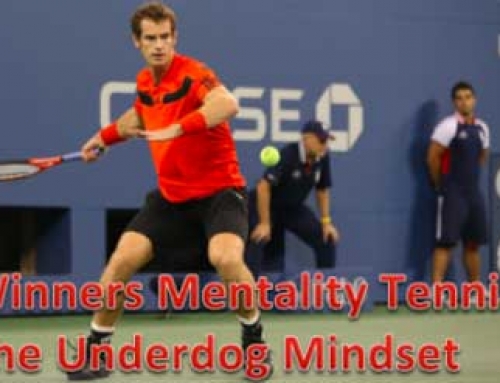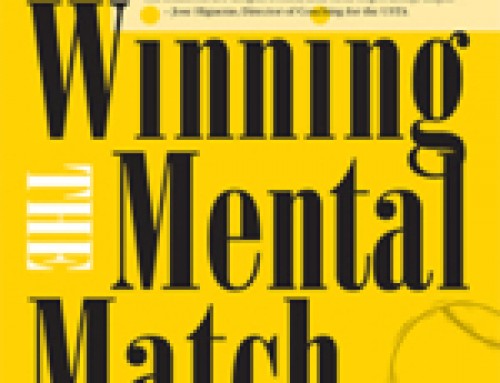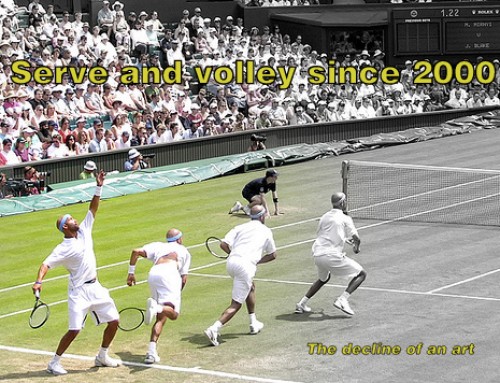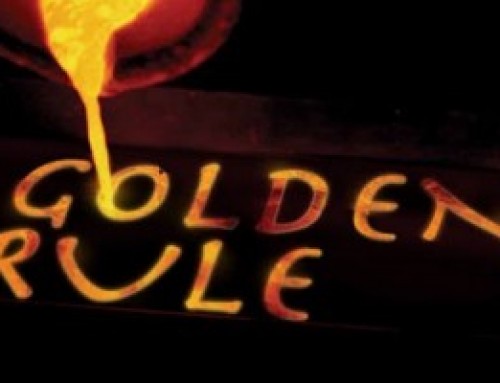This is a guest post from Pete at Winners Mentality Tennis. Check out his website to learn more about improving your mental game to win more matches.
Have you ever found yourself losing to a player that you should be beating easily? Does this happen more often that you’d care to admit?
Your mindset is key
When competitive players are developing their tennis game, they typically focus on the following:
- Equipment
- Technique
- Fitness
While these are three very important areas of the game, one concept that is often overlooked by players with a ranking of 4.5 and lower is that of Mental Tennis. I’m not suggesting that all players overlook these areas, but the vast majority do. All too often do I see a young college kid in a tournament or league match who’s in great shape and hits heavy ground strokes, only to get defeated by an older player who utilizes mental tactics and strategies to win the match. If that is you, don’t worry – we’ve all been here, and we’re here to help.
If you want to take your game to the next level, you’re going to need to develop a solid mental game and strategy. Let’s start by re-prioritizing your focus:
- Mental game
- Technique
- Fitness
- Equipment
Working on improving items 2-4 are fairly straightforward. Want to improve technique? Practice, watch online videos, hire a coach, etc. Want to get in better shape? Do sprints, improve your diet, sign up for Complete Tennis Fitness 2.0, etc. Use equipment that supports your style of play? Find a certified racket technician, read reviews, demo, etc. But how do you improve your mental game and strategy? When players (who don’t have a fully developed mental game or strategy) are asked what their strategy is, you’ll hear:
Uh… Well… Win more points than my opponent. Hit winners. Hit the ball to his backhand…
Or even worse yet:
I don’t really think about a strategy, I just go out there and play.
The responses when asked about mental game are similar. The truth is, when players are originally taught to play tennis, the mental side of the game is completely neglected. This isn’t surprising since tennis is a fairly complex game to learn from a hand-eye coordination perspective. Why would a coach bother instructing an up-and-coming player on strategy when they struggle with keeping the ball in play for more than a few shots? Naturally, you’d expect that players would learn or be taught the mental side of the game once they’ve accomplished the basics. This might be the case for players with good coaches, but that is the minority. Want to know what my high school coach told me when I was losing a close match to a tough opponent?
This kids pretty good, huh? You should try to hit more winners. Just keep fightin’!
While I couldn’t expect him to drop some revolutionary wisdom on me, it really does show the level of tennis know-how that many coaches possess. So how can players improve their mental game? Whether they are just embarking on their tennis journey, or have been playing for years, the answer is the same: Adopt a Winners Mentality. A Winners Mentality allows players of all skill-levels to enhance their mental edge to play more consistently at their peak. The Winners Mentality is extremely apparent while watching some of the ATP Pros (i.e. Federer, Nadal, Djokovic). The Winners Mentality allowed Rafa to win 9 French Open titles after multiple extensive knee injuries. The Winners Mentality allowed Federer to have a dominant career even into his 30’s. The Winners Mentality can be attributed to Nole’s 2011 success. There is an increasing level of top competition in the ATP with Andy Murray, Stanislas Wawrinka, Milos Raonic, Grigor Dmitrov – so how do the top 3 continue to excel on tour? What separates them from the rising stars who have the advantage of youth on their side? Simple – they are masters of the Winners Mentality.
So what is this Winners Mentality?
Simply put, the Winners Mentality is a mindset shift from a player who is results-oriented to a player who is process-oriented. When a player is so focused on the idea of winning, their frustration is apparent when the match doesn’t go their way. Rather, a player who is process-oriented isn’t phased by performance fluctuations, and will often fight for a comeback to the very end. This is why we see Federer, Nadal, and Djokovic come back in many matches when their opponent gets a quick start on them. Top performers with a developed Winners Mentality are systematic and implement a finely-tuned process to achieve their goals.
How can you develop your own Winners Mentality?
There are four areas of your mental game that you will need to develop:
- Purpose
- Focus
- System
- Observation
Purpose
Take a few moments to think about why you play tennis. This may seem trivial, but don’t take this lightly. Are you playing to win a tournament? Become nationally ranked? Just for fun? There is no right or wrong answer here, but being true to yourself will help give you perspective. Having a good understanding of your purpose for playing the game can give you incredible motivation during match play. Rather than reacting to the match, you can start to dictate the match based on your personal purpose. Furthermore, knowing your purpose will help you in accomplishing the other three areas of developing a Winners Mentality.
Focus
If you had any perception of mental tennis prior to reading this, you probably associated it with focus. Focus on the ball. Focus on winning. Focus on hitting to my opponents backhand. I tend to think of focus a bit more abstractly. One mistake you want to avoid during match play – thinking too much. Thinking too much results in unforced errors, discouragement, negative thinking, etc. I’m not suggesting to enter a match with an empty mind, but overthinking can be dangerous. Have you missed a few shots, gotten discouraged, and found yourself in the losers infinite loop?
The important factors for good focus is maintaining a clear mind, recognizing your purpose, and implementing your system (discussed next). Maintaining a clear mind is a challenge for many players – remember Marat Safin smashing his rackets? A simple and effective way to keep your mind clear of negativity is to become process-oriented rather than results-oriented. Rather than getting upset that your not winning the match, you can focus all of your energy on playing with a purpose and also implementing your system.
System
Every professional tennis player has a developed and refined system – some are just more apparent than others. The most noticeable components of a developed system are habits – Nadal’s routine before points, Sharapova’s routine after points, Djokovic’s ball bouncing before a serve. Players develop habits to help return their mind to a steady state, a baseline if you will (get it?). These habits, rituals, superstitions can appear obsessive compulsive to bystanders, but they are extremely effective in clearing your mind and following a system. Developing a system consists of what habits (if any) you perform, as well as what you intend to do during points, in between points, and throughout a match. It consists of how you react to your opponent, court conditions, weather conditions, etc. Additionally, your system consists of your game plan. How do you intend to use your existing skill set against your opponent? Are you typically an aggressive baseliner, but your opponent is a pusher? Maybe you will leverage your heavy hitting to set up easy put away shots. Maybe you are a serve and volleyer, but you know that your opponent likes to hit a lot of lobs. How would you react? Before each and every single match, you should have some concept of a game plan in mind. By doing so, when the going gets tough, you can clear your mind, get back to your steady state, and follow your game plan. Simply put, this allows you to follow your own developed system of play rather than simply being reactive and playing your opponents game. Players who develop a system and implement it dictate matches. Players without a system are reactive and fall into the trap of playing their opponents game.
Observation
This can have a lot of varying meanings to different players. Two focal points that I want to discuss today are: Recognizing momentum and reading your opponent. Recognizing momentum is a two-way street. First, you can recognize when your opponent is struggling whereby you can attack and build momentum. Secondly, you have to recognize when your opponent is gaining momentum so that you can put an end to it. The former is an easy one, when you see that your opponent is struggling by visual cues (i.e. body language, verbal excitation, equipment deformation, etc.), don’t take your foot off of the gas pedal. When your opponent is beating themselves up for their play, don’t give in and think that the match is over. First, that can be dangerous, because if you play lackadaisically they can channel their frustrations into a comeback. Second, they are doing the hard work of beating themselves up – this is your golden ticket to finishing off the match.
The other end of the spectrum is when you’ve had a rough bout and your opponent is starting to build momentum. Recognizing that they are building momentum can be a match-saving realization. Rather than getting down on yourself, you’re going to implement your system, right? Play with your purpose, clear your mind, remember your game plan, implement your system. When your opponent is gaining momentum, you can do one of two things: mix things up, or dare them. By mixing things up, you are essentially trying to throw them off and get them out of their groove by hitting new material at them. Has your opponent been ripping winners off of your topspin groundstrokes? Throw in some low slices. Has your opponent been hitting great volley angles? Try lobbing them. Has your opponent been teeing off on your kick serve? Try a slice serve. Is your opponent hitting ace after ace? Slow the match down, take your time (within reason of course). There are numerous ways to mix a match up, so try various tactics out.
The latter option is the dare them Beyond observing momentum is reading your opponent. Observe their style of play. Build your tennis intelligence to quickly and accurately assess their strengths and weaknesses. Yes, a weak shot will be glaring you in the face, but a lot of subtle weaknesses can be hidden well. For example, big hitters often are not very mobile. This may sound obvious, but when your mid way through a match and you’re being out-gunned by the opposition, try moving them around the court more – hit drop shots, hit low slices, hit heavy topspin to the backhand side, hit heavy topspin to the forehand side. Moving a big hitter around can pay extreme dividends – they may not have the endurance to keep pounding the ball when you are moving them all over. Tire out the big hitter and you’ll have a much easier time taking command of the match. So next time you hit the courts, actively try to work on your mental game. Remember to play with a purpose, to focus your mind, develop and implement a system, and to observe your opponent during match play. Work on these four areas of your mental game, and you will start to see the results. Think like a winner, play like a winner. Have you ever come from behind to win a match? Leave a comment below and tell me about it!








